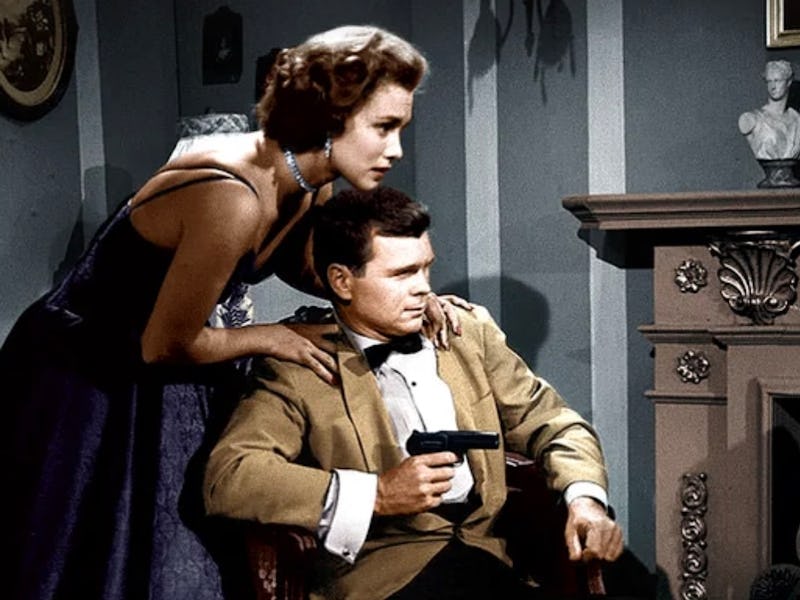The First James Bond Was American and on TV
The first onscreen Bond still remains very undercover.

Everyone knows that the first James Bond movie was 1962’s Dr. No, starring Sean Connery. But eight years earlier, Bond had actually made his onscreen debut on TV — and he was American. On October 21, 1954, on the CBS anthology series Climax!, agent James Bond made his debut in a 50-minute adaptation of Casino Royale, which had only been published one year prior in 1953. So, although James Bond’s screen adventures began in earnest with Sean Connery in the 1960s, the 1950s featured a Bond misfire that represents a bizarre alternate universe, one in which James Bond wasn’t at all the man we think of today.
James Bond author and creator Ian Fleming was paid $1,000 (roughly $11,721 in 2024 dollars) to allow Casino Royale to become a TV movie. This was a deal Fleming pursued and brokered before he had a book contract; which is why the Climax! version of Casino Royale came out so soon after the book was published. A slightly more contemporary example of this would be Michael Crichton selling the film rights for Jurassic Park before the book was published in 1990. Fleming was so fixated on getting a movie or TV deal for Bond, that he fired off a wire to a Hollywood correspondent named J.M Ruddy asking for advice as to “what sums do studios pay for not yet established writer?”
The initial answer was $600 dollars for the option for a feature film version of Casino Royale, and later the $1000 from CBS. As biographer Nicholas Shakespeare points out, the TV deal for Casino Royale made Fleming’s desire to make Bond movies even stronger, noting that, “From then on, his Hollywood aspirations accelerated downhill.”
Unlike many authors, who are possessive of their books, and afraid for the novels to be ruined, Fleming was seemingly eager to sell out. And so, the resulting first filmed James Bond adventure demonstrates that the Bond franchise needed time to evolve before making the leap from prose to screenplays. While there’s a certain amount of tantalizing novelty to watching this version of Casino Royale today, not even the strangest hardcore Bond fanatic could call this their favorite version of the character. Barry Nelson plays Bond in the way you think of guest stars on The Twilight Zone, not particularly bad, but certainly not memorable or charismatic. In a way, Michael Pate as agent “Clarence Leiter,” steals the show, calling Bond “card-sense Jimmy Bond,” and giving him the basic details of his mission.
As in the novel (and the 2006 film) Bond is there to take down mega-villain Le Chiffre (Peter Lorre ) at the card table, and later has to battle the villain physically, too. Bond is an American here, part of a “combined intelligence” agency, and Leiter is English, swapping the nationalities of the characters from the book. If you’ve only ever seen the 2006 movie and never read the book, the Climax! version of Casino Royale will scan as a passable rough draft of the Daniel Craig film. This is because, for all of its clunkiness, and the bizarre fact that Bond is not from the U.K., the 1954 Casino Royale is fairly faithful to the book. Yes, the character of Vesper Lynn was changed to the composite character of Valerie Mathis (Linda Christian), and far less electric than she is in the novel or later embodied Eva Green. And yet, the broad plot strokes are here: The high stakes card game, Bond being captured and tortured by Le Chiffre, and even the love affair between Bond and Valerie, who, in this version, is a former lost love, rather than someone new. (This is an idea that the 1997 Pierce Brosnan film Tomorrow Never Dies recycled in the form of Teri Hatcher as Paris Carver.)
The reason why the original Casino Royale is a bare-bones version of the familiar Fleming story is that the author’s novels were quite short, and in a way, written as screen treatments to begin with. Later, in 1956 when corresponding with a different producer about the possibility of Moonraker (published in 1955) becoming a film, Fleming said: “I originally thought of this book as a film.”
Ian Fleming, dreaming of James Bond books or films?
Would Bond have been forgotten had the only version ever been Barry Nelson? In a global sense, the answer is unknowable. The novels were very popular in the 1950s, to the point that even John F. Kennedy was a fan, citing From Russia With Love (1957) as one of his favorite books. And yet for most people today, the Bond franchise came into existence on October 5, 1962, with the film version of Dr. No — the day that Global James Bond Day is celebrated.
Fleming spent several years after 1954 writing screen treatments for his own books, none of which were ever filmed. This means that while he was continuing to write the exploits of James Bond in book form (roughly a book a year until his passing in 1964), he was also working on a phantom 007 film franchise, which never existed. Today, the only evidence of this other cinematic Bond world is the 1954 Casino Royale, which, by all accounts, didn’t truly capture the essence of the character, even if the plot was close enough. Fleming didn’t dwell too much on this artistic inconsistency. At the time, he was clearly happy to mix up a martini and cash the check.